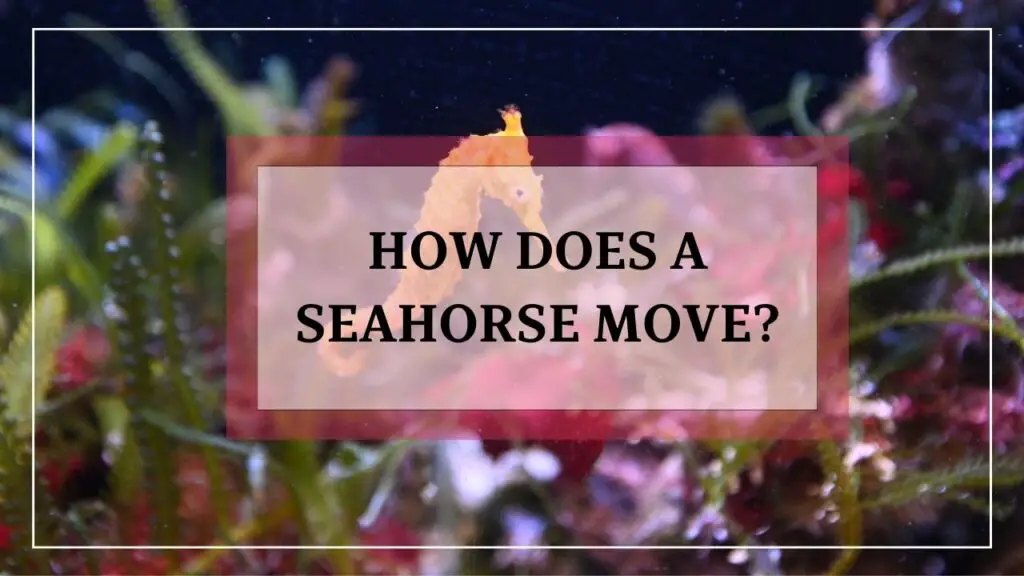Today, we embark on a remarkable journey into the enchanting realm of seahorses. These fascinating creatures, with their delicate grace and mesmerizing movements, never fail to leave us in awe.
In this blog post, we’ll unveil the secrets behind how seahorses navigate the watery depths.
So, get ready to be amazed as we delve into the intricate mechanics of their locomotion.
Whether you’re a budding marine biologist or simply curious about these mystical creatures, join me as we uncover the hidden wonders of the seahorse movement. Let’s dive right in!
Understanding the Unique Body Structure of Seahorses

Let’s take a closer look at these delightful beings and their one-of-a-kind physical characteristics. Get ready to marvel!
Description Of The Seahorse’s Physical Characteristics
Picture this: a seahorse has a body that resembles a slender pipe, a bit like a mini underwater chimney. It’s not your everyday fish shape, that’s for sure! But that’s what makes them so special.
1. Long, Slender Body Resembling A Pipe
Seahorses have bodies that are long and slender, almost like a pipe. It’s as if they decided to defy the typical fish body shape and go for something more unconventional. This unique physique allows them to move with grace and agility through the water, performing their underwater ballet.[1]
2. Curved Neck And Distinctive Horse-Like Head
Now, let’s focus on their necks and heads. Seahorses boast a curved neck that leads up to a distinctive horse-like head. Yes, you heard that right—a horse-like head on a fish! It’s like nature decided to blend two different creatures just for the fun of it.
Role Of Body Shape In Their Mode Of Movement
You might be wondering, “Why such a particular body shape?” Well, my friend, the seahorse’s unique physique plays a crucial role in their mode of movement. Their slender bodies allow for delicate maneuvers through the water, while their curved necks and distinctive heads give them better control and balance. It’s like they were designed for underwater acrobatics!
So, imagine a tiny underwater chimney… um, I mean seahorse, gracefully gliding through the currents with its curvy neck and horse-like head leading the way. It’s a sight to behold and trust me, you won’t find anything quite like it in the vast ocean.
The Propulsion Mechanism of Seahorses
Prepare to witness an unconventional means of movement that will make you say, “Whoa, I never saw that coming!”
Unconventional Means Of Locomotion
So, here’s the thing: seahorses have a rather unique way of getting around the underwater playground. They don’t rely on the typical tail propulsion like most fish. Oh no, they have something way more intriguing up their fins.
1. Dorsal Fin As The Primary Source Of Propulsion
Enter the superstar of seahorse locomotion—the dorsal fin! This fin, located on its back, takes center stage when it comes to propelling these marvelous creatures through the water. It’s like their very own secret weapon.
2. Fluttering Movements And Ripple Effect For Forward Thrust
Now, imagine this: the seahorse’s dorsal fin flutters with incredible speed—up to 35 times per second! It’s like a rapid-fire fluttering frenzy. And what does this magical fluttering do? It creates a ripple effect in the water, resulting in a forward thrust that propels the seahorse gracefully forward.
Independent Control Of Each Fin Movement
But wait, there’s more! Seahorses have an incredible superpower—they can control each fin movement independently. It’s like they have a built-in GPS and joystick combo. This remarkable ability allows them to navigate through the water with precision and finesse.
1. Seahorses’ Ability To Navigate With Precision
Imagine the seahorse gliding effortlessly through the currents, adjusting its fin movements with utmost accuracy. They can make subtle adjustments, change directions, and maneuver around obstacles like underwater maestros. It’s like they’re performing an aquatic ballet!
2. Comparison To An Underwater Steering System
Think of it as their very own underwater steering system. You know, like those fancy cars that can maneuver through tight spaces effortlessly? Well, seahorses have got that down pat. They can slalom through the water, making all the other fish green with envy.
So, my friend, picture a seahorse fluttering its dorsal fin with lightning speed, creating ripples in the water and gracefully navigating through the ocean like a pro. It’s a mesmerizing sight that showcases the beauty and ingenuity of these remarkable creatures.
The Intricate Role of Dorsal Fins
This marvelous appendage holds many secrets to their graceful movement. Brace yourself, my friend, as we unravel the intricate role of the seahorse’s dorsal fin and explore the hidden wonders within.
Dorsal Fin As Miniature Wings
You know, when I look at a seahorse’s dorsal fin, I can’t help but think of miniature wings. It’s like they have their very own underwater flight apparatus. How cool is that?
1. Fluttering Speed (Up To 35 Times per Second)
Get ready to have your mind blown, because the seahorse’s dorsal fin can flutter with lightning speed—up to 35 times per second! It’s like a tiny fin-powered propeller in action. That’s some serious fin-flapping prowess, my friend!
2. Creation Of Vortices In The Water For Propulsion
Now, here’s where the magic happens. As the seahorse’s dorsal fin flutters with lightning speed, it creates vortices in the water. Picture swirling water currents, like tiny underwater tornadoes. These vortices are the secret sauce behind the seahorse’s propulsion—they provide the forward thrust that propels them gracefully through the ocean depths.
Significance Of Pectoral Fins In Stabilization And Steering
But wait, there’s more to the seahorse’s fin-tastic abilities! Let’s not forget about their trusty sidekicks—the pectoral fins. These fins, located near their heads, play a significant role in the seahorse’s maneuverability and control.
1. Location And Purpose Of Pectoral Fins Near The Head
If you take a closer look at a seahorse, you’ll notice that their pectoral fins are strategically positioned near their heads. It’s like having your steering wheels right where you need them!
2. Hovering Abilities And Balance Maintenance
The pectoral fins grant the seahorse incredible hovering abilities and help maintain its balance. They can use these fins to stay in one spot, almost like they’re defying gravity. Talk about being the masters of stability!
The Marvels of Seahorse Fins
Oh, my friend, get ready to be dazzled by the marvelous world of seahorse fins! These magnificent creatures have some truly remarkable appendages that will leave you in awe. Let’s dive in and explore the wonders of their fins.
Bone Structure In Pectoral Fins
Let’s start with the seahorse’s pectoral fins—the unsung heroes of their aquatic escapades. These fins are not your average fish fins, oh no. They’re a spectacle in their own right.
1. Abundance Of Bones Compared To Other Fish Species
You know, if you were to take an X-ray of a seahorse’s pectoral fin, you’d be in for a surprise. These fins are packed with an abundance of bones, more than your regular fish. It’s like they have a mini bony army hidden in there!
2. Importance Of Flexibility And Dexterity For Precise Movements
But what’s the significance of all these bones, you might wonder? Well, my friend, it’s all about flexibility and dexterity. The seahorse’s pectoral fins allow for precise movements and fine-tuned control. It’s like having an underwater ballet dancer’s limbs—graceful, agile, and utterly mesmerizing.
Versatility And Functionality Of The Prehensile Tail
Ah, now let’s shift our attention to the seahorse’s prehensile tail—a true marvel of the underwater world. This tail is a game-changer, my friend, and it’s as versatile as a monkey’s tail. Yes, you heard that right—a monkey’s tail underwater!
1. Comparison To A Monkey’s Tail
Just like a monkey’s tail, the seahorse’s prehensile tail is capable of grasping and holding onto objects. It’s like having an extra set of hands. Can you imagine having a tail that can do all the heavy lifting and gripping? It would be quite handy!
2. Anchoring, Gripping, And Stability Maintenance Capabilities
The seahorse’s prehensile tail is not just for show, my friend. It has a multitude of functions. They can use it to anchor themselves to corals or seagrasses, providing stability and allowing them to stay put even in strong currents. It’s like having a built-in anchor that keeps them grounded.
But that’s not all! The prehensile tail also assists in gripping onto objects, whether it’s a piece of seaweed or another seahorse during courtship dances. It’s like having a built-in hand for those delicate interactions. Talk about a multitasking tail!
Conclusion
In conclusion, the seahorse’s unique body structure and incredible fins have captivated us on this journey. Their long, slender bodies and distinctive heads set the stage for their graceful movement.
With their fluttering dorsal fins and independent control, seahorses navigate with precision, propelled by the vortices they create.
The pectoral fins near their heads contribute to stability and steering, while their prehensile tails amaze with gripping capabilities and anchoring prowess.
It’s a marvel to witness the intricate dance of seahorse locomotion.

Hi, I’m Ali Tarek, the founder of Animalsman. I’ve always been passionate about pets, especially dogs and cats, and I created this website to share practical tips, easy recipes, and helpful care advice for fellow pet lovers. My goal is to make pet care simple, enjoyable, and accessible for everyone. When I’m not writing or curating content, you’ll usually find me spending time with my furry friends or learning new ways to keep them happy and healthy.



